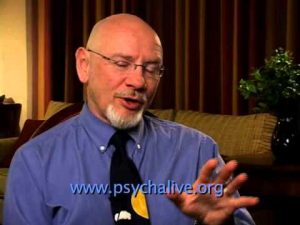VIDEO: Dr. Kirk Schneider on Awakening to Awe, Gang Leader to Advocate
Watch an excerpt from PsychAlive’s interview with Dr. Kirk Schneider.
Dr. Kirk Schneider – Awakening to Awe, Gang Leader to Advocate
Lisa Firestone: So in your book about Awakening to Awe you tell different stories of people’s experiences with awe and I was wondering if maybe you could recount one of those or think of one or an example of that.
Kirk Schneider: Well, one example is the life of Jim Hernandez, who is a former gang leader in the Bay Area and who’s now a youth advocate and a gang mediator and much more, very spiritually and emotionally centered person. Jim came around to this actually through the writings of Rollo May.
That was kind of his initial sparks and his initial steps out of the gang world and as he recounts it, he read Art of Counseling and that really inspired him to reassess his life, reassess, you know, the direction he was going and realize that there was a lot more, a lot more that he was missing. That one could come out of tragic circumstances, I think the existential part was very powerful for him, that one could come out of very painful circumstances and not only manage, you know, following that, but actually thrive, actually become more alive, more free.
And this moved him to take a chance and call Rollo one day. And apparently Rollo greeted him very warmly and he said you can come and visit me and that visit was life turning for Jim even though Rollo turned him away. Rollo actually said that he had a younger colleague that he thought might interest Jim, and that colleague happened to be me.
So that’s where I met Jim, and that started a very long sort of philosophical, consultive, personal, intimate connection. And Jim discovered, well, we talked about the works of Kierkegaard and Nietzsche, some of the recent psychologists, Becker and Rollo May and Jim Buggenthal and so on and so on. And so a lot of it for him was in really processing this stuff and our discussions were centered a lot about how does this relate to his life.
And a lot of it was about getting out of the narrow identifications, with having to be, you know, the big guy on the block or take vengeance on somebody who hurt or killed a fellow gang member. I mean, it was all about reactivity, kind of knee jerk reaction, doing everything one can to avoid a sense of vulnerability or the pain of smallness, so they had to exercise their greatness, you know, to this brutal degree. And through the dialogues, the literature, a lot of time alone, too — I think solitude can be a very important part of cultivating a sense of awe too…and by the way, something else that seems to be missing in our culture a lot, because we seem to be tethered to things, devices, so much.
And I’m not saying the communal is not important, I think it’s hugely important. I’m talking about substantive time alone, one’s imagination, one’s experience of life. So for Jim, a lot of it was finding out more about nature and the woods, taking time for that. It was his artwork, too. And he had some beautiful paintings. I saw his gallery. And these were ways of opening up to his imagination, his deeper emotions, portraying some of the things he went through, but with beauty, too and hope.
And that kind of work also lead him to a connection to his Mayan roots, which were very important for him to reconnect with. And, again, I hope you’re seeing how these connections are so much larger, so much richer than the kind of narrow reactive places that many people are in, that I was in, I am in at times. But how gang life can be very narrow and reactive and not necessarily have that kind of depth of appreciation for one’s ancestors, for one’s sacred ritual, for the art, the beauty of it and all of these fuller identifications helped him to open up.
And eventually he brought a lot of his sensibilities to the school system. And he actually began what he called an awe-based culture class at one of his school systems and I had the great fortune of sitting in on one of those classes and it was beautiful to see. Jim relating to the kids – these were younger kids – elementary school, 5th grade or so. But not just the way he related and his sort of natural street cred, authority. But his colorful costumes,
KS: having them engage in dances and ancient ritual and having them embody places that they wouldn’t normally at all experience.
And that again got them in touch with a much bigger picture of living. And a kind of inner freedom that he was experiencing as well and wanting to share that, so I can’t over-emphasize inner freedom. I really feel that that’s the crux here.
Tags: awe, video









Leave a Reply